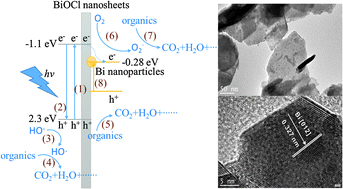Photocatalytic properties of Bi/BiOCl heterojunctions synthesized using an in situ reduction method
Abstract
Bi nanoparticles are grown on BiOCl nanosheets via an in situ chemical reduction in a KBH4 aqueous solution. Bi/BiOCl nanosheets with different contents of Bi nanoparticles can be achieved by changing the concentration of the KBH4 solution. The structure, morphology, elemental composition and optical absorption performance are characterized using an X-ray diffraction diffractometer, a scanning electron microscope, a high resolution transmission electron microscope, an X-ray photoelectron spectrometer and a UV-Vis diffuse reflection spectrometer. The photocatalytic activities of the as-prepared photocatalysts are tested using the degradation of methyl orange under both UV light and visible light irradiation. Bi nanoparticles modified on BiOCl nanosheets not only enhance the photocatalytic activity under UV light irradiation, but also achieve visible light photocatalytic activity. The mechanism of the photocatalytic processes, such as optical absorption, charge transfer and surface reactions, for the Bi/BiOCl nanosheets are discussed in detail.


 Please wait while we load your content...
Please wait while we load your content...